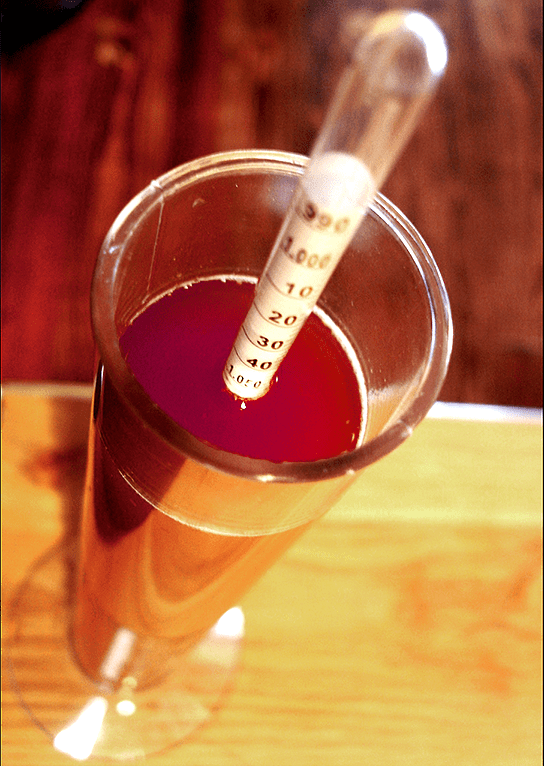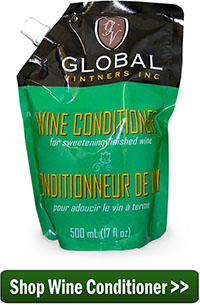 Most wine recipes give a SG [specific gravity] for starting fermentation and at the completion of fermentation. My wine usually ends up dry, so when I bottle it I usually stabilize it and back-sweeten most of it. I’ve been just adding sweetener a little at a time and tasting until I think it is about right, but that’s a little hard to hit and very unscientific.
Most wine recipes give a SG [specific gravity] for starting fermentation and at the completion of fermentation. My wine usually ends up dry, so when I bottle it I usually stabilize it and back-sweeten most of it. I’ve been just adding sweetener a little at a time and tasting until I think it is about right, but that’s a little hard to hit and very unscientific.
What about using a hydrometer to adjust wine sweetness and is there an approximate hydrometer reading for what they call dry, semi-dry and sweet?
What about white table wines, red table wines, sweet table wines, dessert wines etc do all of these different wines fall under the same category of dry, semi-dry or sweet?
Thanks
Glen L. – IA
—–
Hello Glen,
While there are certain ranges on the specific gravity scale that one could consider sweet verses dry, these ranges are so narrow on the typical wine hydrometer that it would be very hard to accurately apply them to sweetening a wine. In fact, I could not really tell you what the ranges would be because I have never paid that much attention to them.
There are also a couple of other reasons why using a hydrometer to adjust wine sweetness is not all that practical:
 You could have two different wines sweetened to the same specific gravity reading and they could have very different impression of sweetness. What is coming into play is how the other flavor components of the wine work with the sugar to form the wine’s character. As an example, if the wine is rich and earthy as opposed to crisp and fruity, then more sugar may be needed in the former case than in the later wine to achieve the same impression of sweetness. This is all subjective, of course, but the principle rings true.
You could have two different wines sweetened to the same specific gravity reading and they could have very different impression of sweetness. What is coming into play is how the other flavor components of the wine work with the sugar to form the wine’s character. As an example, if the wine is rich and earthy as opposed to crisp and fruity, then more sugar may be needed in the former case than in the later wine to achieve the same impression of sweetness. This is all subjective, of course, but the principle rings true.
- A wine’s body or lack of body could cause two wines that taste equally dry to have two different readings on the wine hydrometer. Body raises the specific gravity without raising sweetness. In this case, if you have a full-bodied wine and a thin, crisp wine and you sweeten them both to the same reading on the specific gravity scale the hydrometer, the full-bodied will have less residual sugar than the thin crisp wine. Part of the SG reading is being made up with body, not sugar.
So as you can start to see, depending on hydrometer readings to adjust your wine’s sweetness may not be as accurate as just tasting the wine. After all it is how the wine tastes to us humans – and more specifically, you – that matters most, not what the hydrometer says.
 The wine industry does use a sweetness scale to give customers a clue as to how sweet a wine might be before they purchase it. The scale goes from 1-9 with 1 being the driest, and it is based on percentage of sugar by weight in the wine. While this scale may be used as a marketing tool, I find it hard to imagine any commercial winemaker setting out to target a particular number, rather they would do just as you are doing – going by how the wine tastes and how sweetness is working in concert with the wine’ other characters.
The wine industry does use a sweetness scale to give customers a clue as to how sweet a wine might be before they purchase it. The scale goes from 1-9 with 1 being the driest, and it is based on percentage of sugar by weight in the wine. While this scale may be used as a marketing tool, I find it hard to imagine any commercial winemaker setting out to target a particular number, rather they would do just as you are doing – going by how the wine tastes and how sweetness is working in concert with the wine’ other characters.
Happy Wine Making,
Ed Kraus
—–
Ed Kraus is a 3rd generation home brewer/winemaker and has been an owner of E. C. Kraus since 1999. He has been helping individuals make better wine and beer for over 25 years.

Ed,
I have 5 gallons of blush Zinfindel ready to bottle. I plan to stabilize and then sweeten a little. How do I determine where to start with the sweetening process and how much liquid sugar to prepare for use?
The wine is beautiful and Is my first batch for my wife so I don’t want to screw this up!
Thanks for all if your help and products!
Steve
Steve, Unfortunately since everyone’s desired sweetness level is different, we cannot tell you how much to add. What we recommend is taking a measured amount of wine, sweetening it to your taste and then multiply how much sugar it took by the remainder of the batch. Doing it this way will help to avoid over-sweetening the wine. The article below will discuss this in more detail.
My Wine Is Too Dry
http://www.eckraus.com/blog/wine-is-too-dry
When I sweeten my wine I use 1/4 pound of sugar per gallon and that seems to be just the right
sweetness for my taste.
Hi. I’m new at this wine making game and having a lot of fun learning. Right now I’m make all small batch fruit wine. I was getting ready to bottle two gallons of a mixed berry wine. Both gallons were made at the same time, racked at the same time, and handled the same. After I stabilize the wine, I started to back sweeten. My first gallon turned out great. The next one not so much! Just as soon as I added some sugar, it erupted like a volcano. Never seen that before. Both jugs have been aged the same time (5 months). Any idea on what happened? Could it have been C02 gasses? It didn’t have a off smell, but could it still have spoiled? It has a slit haze to it now. The first Gallon was nice and clear. I left it in the gallon jug (sweet) hoping that if it was gasses it will clear up. The taste was a little off compared to the first gallon but the ph was the same for both.
Ken, it is very possible that while stirring in the sugar the eruption occurred due to the CO2 in the wine. The eruption of sorts was something called nucleation. Nucleation is the same exact principal that causes a 2 liter bottle of soda pop to spew when a Mentose candy is drop into it. Below you will find an article that will discuss this further.
My Wine Erupted
http://blog.eckraus.com/why-did-stirring-my-wine-result-in-an-eruption
What does it mean when you talk about “stabilizing the wine” before bottling! Do I need to add something to it before bottling?
Fran, we always recommend adding a sulfite to a wine such as Campden tablets right before bottling (1 per gallon). This is to keep the wine from spoiling. But there is also something called wine stabilizer. It’s actually potassium sorbate. This is added when the wine is sweetened at bottling time. The stabilizer keeps the wine from fermenting again with the newly added sugars. This would not be good if the wine has been bottled.
Is there a specific kind of hydrometer to use when determining how much sugar to add to fruit juice at the beginning of the wine making process? If I do not want to back-sugar my wine do I need to add a stabilizer? I want a dry wine.
You want a hydrometer that has a “Potential Alcohol” scale, which is almost any wine making hydrometer. This scale will tell you how much alcohol can be made with the sugars that are currently in the wine must. As long as you don’t keep adding sugar past the 13% mark on the scale, you should be able to ferment it all out to a dry wine just fine.
As a side note to help you out: for every pound of sugar you add to a 5 gallon batch, you will raise the potential alcohol by 1%. This is not exact but it is very close.